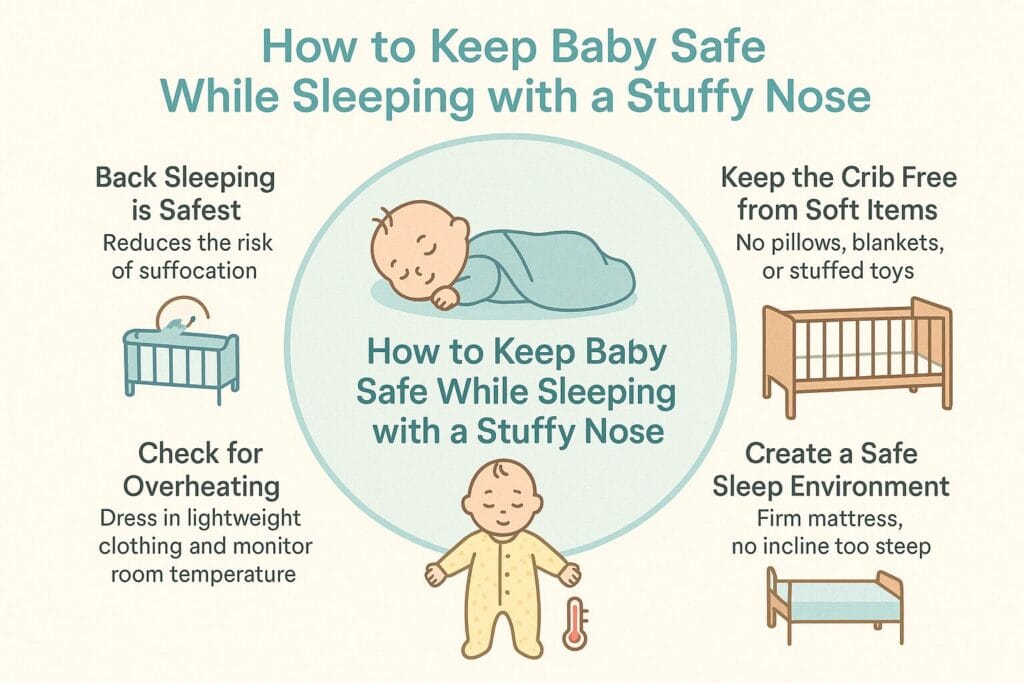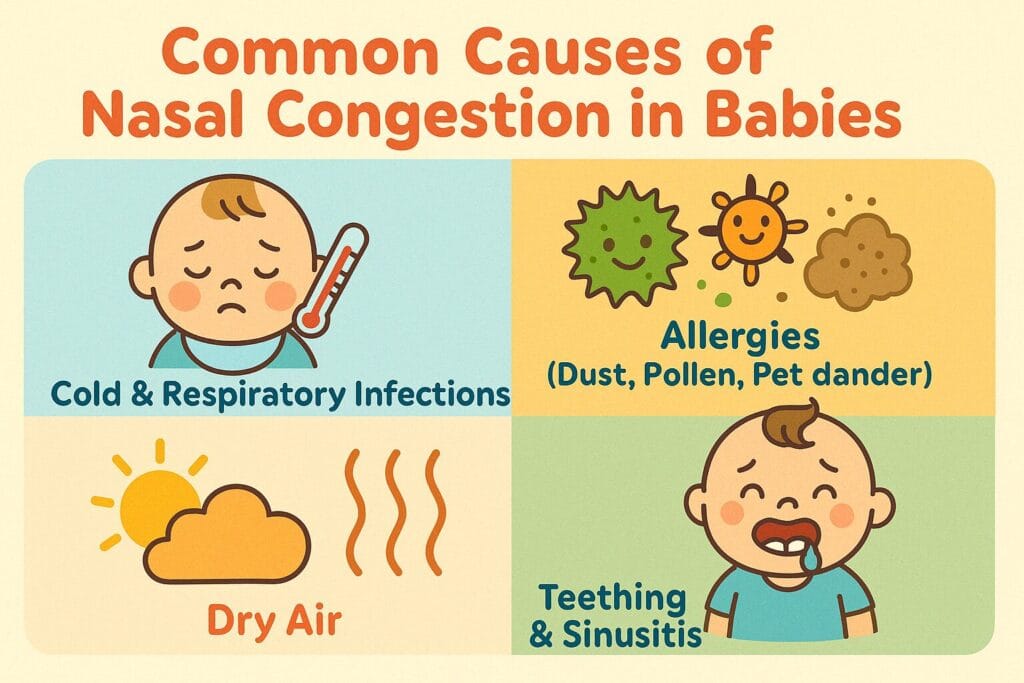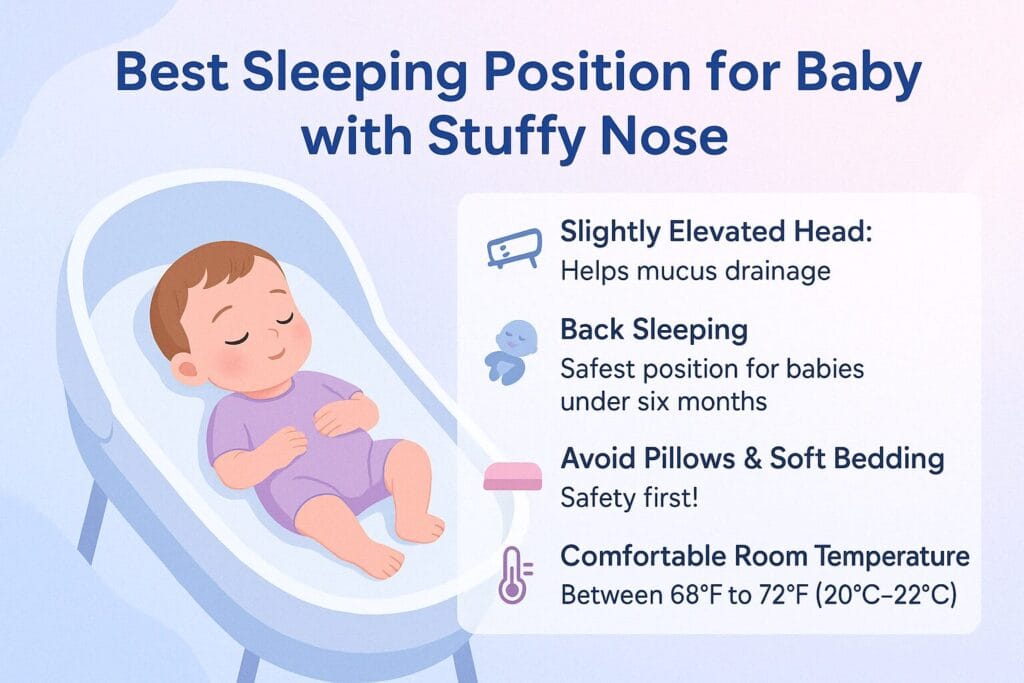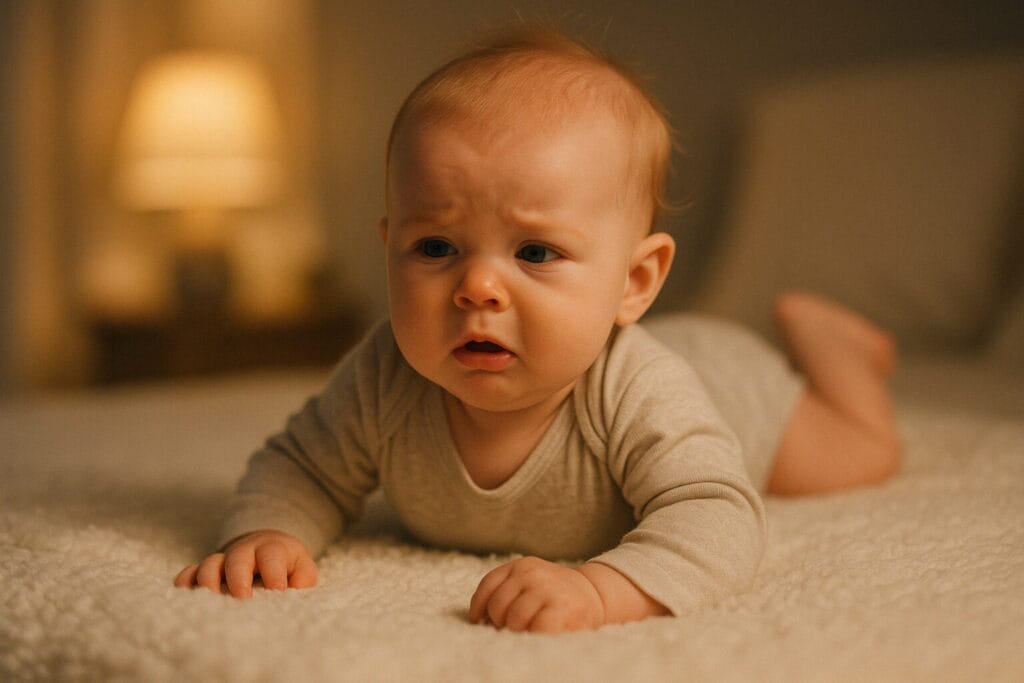When a baby has a stuffy nose, it can be heartbreaking to watch them struggle with breathing, especially when it disrupts their sleep. Nasal congestion can affect a baby’s ability to breathe comfortably, making it harder for them to rest. Finding the best sleeping position for baby with stuffy nose is essential in alleviating this discomfort and ensuring your little one can breathe easily during sleep. In this comprehensive guide, we will cover the best sleeping position for baby with stuffy nose, the causes of nasal congestion, tips for improving airflow, and safety considerations.
By understanding the best sleeping position for baby with stuffy nose, you can improve your baby’s quality of sleep, help them recover faster, and alleviate the discomfort caused by a blocked nose.
Table of Contents
Why Nasal Congestion Affects Your Baby’s Sleep

When babies have a stuffy nose, it significantly impacts their ability to sleep soundly. Nasal congestion in babies is common and can occur for various reasons, such as colds, allergies, or even teething. Babies are primarily nasal breathers, meaning any blockage in the nasal passages can lead to difficulty breathing, feeding, and sleeping. Therefore, identifying the best sleeping position for baby with stuffy nose is critical to helping your baby breathe better during rest and improve overall sleep quality.
The best sleeping position for baby with stuffy nose promotes mucus drainage and reduces the pressure in the nasal passages, allowing your baby to breathe with ease. However, selecting the right position isn’t just about comfort—it’s about finding a position that allows your baby to rest safely and securely.
Common Causes of Nasal Congestion in Babies

Before delving into the best sleeping position for baby with stuffy nose, it’s important to understand what causes the stuffy nose in the first place. Nasal congestion in babies can be triggered by several factors, and recognizing these causes can help in choosing the best sleeping position for baby with stuffy nose and other effective treatments.
Cold and Respiratory Infections
One of the leading causes of a stuffy nose in babies is the common cold or respiratory infections. These viral infections cause inflammation and swelling of the nasal passages, leading to mucus buildup. For babies, this means difficulty breathing, especially during sleep. Finding the best sleeping position for baby with stuffy nose is crucial during these times to help ease their discomfort and allow for better sleep.
Allergic Reactions
Another common cause of nasal congestion is allergies. Dust, pollen, and pet dander can trigger allergic reactions in babies, causing their nasal passages to swell. The best sleeping position for baby with stuffy nose can help reduce congestion and improve airflow, allowing your baby to breathe easier and sleep more comfortably.
Dry Air
Dry air, especially in air-conditioned or heated rooms, can dry out the nasal passages of babies, causing irritation and increased mucus production. Dry air is a significant contributor to nasal congestion, and ensuring your baby’s environment has the right level of moisture can enhance the effectiveness of the best sleeping position for baby with stuffy nose.
Teething and Sinusitis
Teething, while usually associated with oral discomfort, can also lead to mild nasal congestion in babies. Additionally, sinusitis (an infection in the sinuses) can cause significant nasal congestion and discomfort. Regardless of the cause, using the best sleeping position for baby with stuffy nose can help ease the symptoms and promote more restful sleep for your baby.
The Importance of the Best Sleeping Position for Baby with Stuffy Nose
The best sleeping position for baby with stuffy nose plays a significant role in promoting better breathing. When babies sleep in positions that support the natural drainage of mucus, they can breathe more easily, which leads to a better quality of sleep. Ensuring that your baby’s head is slightly elevated can encourage mucus drainage and relieve nasal congestion.
However, it’s essential to remember that the best sleeping position for baby with stuffy nose should also prioritize safety. Babies under six months are particularly vulnerable to risks such as SIDS (Sudden Infant Death Syndrome), so it’s essential to follow safe sleep guidelines when selecting the best sleeping position for baby with stuffy nose.
The Best Sleeping Positions for a Baby with Stuffy Nose

There are several sleeping positions that can help alleviate nasal congestion in babies. Understanding these positions and how they support your baby’s breathing is key to finding the best sleeping position for baby with stuffy nose.
1. Elevated Head Sleeping (Ideal for Back Sleepers)

Elevating your baby’s head is one of the best sleeping position for baby with stuffy nose strategies. This position helps mucus drain from the nasal passages, making it easier for your baby to breathe. Elevating the head while your baby is lying on their back promotes proper airflow and helps reduce nasal congestion, allowing them to sleep better.
- How to Achieve This Position Safely: You can safely elevate your baby’s head by placing a rolled towel or a wedge underneath the crib mattress. Make sure the incline is gentle and not too steep to avoid discomfort or suffocation risks.
- Important Safety Tip: Never place pillows or soft bedding inside the crib, as they can increase the risk of suffocation. Always use a firm mattress and avoid soft objects near your baby’s sleeping area.
2. Side Sleeping (For Older Babies Who Can Roll Over)
Side sleeping can help relieve nasal congestion in babies by encouraging the natural drainage of mucus. However, this position is only safe for older babies who are capable of rolling over independently. For babies under six months, side sleeping is not recommended due to the risk of suffocation if the baby rolls onto their stomach.
- Why It Helps: The best sleeping position for baby with stuffy nose can include side sleeping, as gravity helps drain mucus from the nasal passages, making it easier for your baby to breathe.
- Precautions: Always supervise your baby while they are side sleeping to ensure they do not roll onto their stomach. The best sleeping position for baby with stuffy nose should focus on safety, especially for babies who are still too young to roll over on their own.
Is your newborn rolling to their side while sleeping? Discover 5 essential tips for ensuring their safety and promoting peaceful rest. Learn how to keep them safe and comfortable.
3. Back Sleeping with a Slight Head Tilt
Back sleeping remains the safest position for babies under six months. By slightly elevating the head during back sleeping, you can create the best sleeping position for baby with stuffy nose. A slight tilt helps with mucus drainage and ensures that the nasal passages remain clear, allowing your baby to breathe more easily.
- How to Achieve the Tilt: Place a small wedge or rolled towel underneath the crib mattress to create a gentle incline. This will help your baby breathe easier and improve sleep quality.
- Safety Tip: Always ensure your baby sleeps on their back to reduce the risk of SIDS. The best sleeping position for baby with stuffy nose can still be achieved safely by using a slight incline with back sleeping.
4. Tummy Time (For Improved Nasal Drainage During Wakefulness)
While tummy time is not a sleeping position, it is an essential activity for improving nasal drainage. Babies with nasal congestion can benefit from tummy time, which helps them clear mucus from the nasal passages and strengthens their neck and back muscles.
- How Tummy Time Helps with Congestion: Tummy time encourages your baby to lift their head, which helps mucus drain naturally from the nasal passages. While not a sleeping position, tummy time contributes to the best sleeping position for baby with stuffy nose by promoting better airflow.
- Safety Reminder: Always supervise your baby during tummy time and never let them sleep on their stomach. Tummy time should only be practiced when the baby is awake and under supervision.
Worried about your baby rolling onto their stomach while sleeping but unable to roll back? Learn what to do for your baby’s safety and comfort.
Additional Tips to Help Your Baby Sleep with a Stuffy Nose

In addition to choosing the best sleeping position for baby with stuffy nose, there are several other methods to alleviate congestion and promote better sleep. These additional steps can complement the best sleeping position for baby with stuffy nose, ensuring your baby breathes easily and sleeps comfortably.
1. Use Saline Nasal Drops
Saline nasal drops are an effective and gentle way to loosen mucus in your baby’s nose. By using saline drops before bedtime, you can help clear the nasal passages, making it easier for your baby to breathe while they sleep. This can improve the effectiveness of the best sleeping position for baby with stuffy nose.
- How to Use Saline Drops: Place one or two drops of saline into each nostril and wait a few moments for the mucus to loosen. You can then use a nasal aspirator to remove the loosened mucus, clearing the nasal passages.
2. Nasal Aspirators (Bulb Syringes)
A nasal aspirator is a helpful tool for removing mucus from your baby’s nose before bedtime. Gently using the aspirator can ensure that your baby’s nasal passages are clear, making it easier for them to breathe while they sleep.
- How to Use Safely: Always use the nasal aspirator gently to avoid irritating your baby’s delicate nasal passages. Limit its use to prevent further irritation, and only use it when necessary.
3. Use a Humidifier to Moisturize the Air
A humidifier is a great tool to help relieve nasal congestion by adding moisture to the air. Moist air helps to soothe irritated nasal passages and prevents the nose from drying out. This makes the best sleeping position for baby with stuffy nose even more effective.
- Tip for Parents: Keep the humidifier clean to avoid mold buildup, which could worsen respiratory issues. A clean and properly functioning humidifier can improve your baby’s breathing and help them sleep more comfortably.
4. Warm Baths or Showers
A warm bath or shower before bedtime can help clear your baby’s stuffy nose. The steam from the warm water helps loosen mucus, making it easier for your baby to breathe.
- How It Helps: Warm, moist air from the bath or shower can reduce congestion and make it easier for your baby to breathe, especially when combined with the best sleeping position for baby with stuffy nose.
When to Call the Doctor
If your baby’s nasal congestion persists or worsens despite using the best sleeping position for baby with stuffy nose, it’s important to consult a pediatrician. Persistent or severe congestion may indicate an underlying health condition that requires medical treatment.
FAQS
1. What is the best sleeping position for a baby with a stuffy nose?
The best sleeping position for baby with stuffy nose involves elevating the baby’s head slightly while they sleep on their back. This position helps facilitate mucus drainage and keeps the airways clear, allowing the baby to breathe easier during sleep. Avoid using pillows directly in the crib, as they can be a suffocation hazard.
2. Is side sleeping a good option for babies with a stuffy nose?
Side sleeping can help with mucus drainage and relieve congestion, making it an effective sleeping position for baby with nasal congestion. However, side sleeping is only safe for babies who can roll over on their own. For babies under six months, back sleeping is the safest position and also one of the best sleeping positions for baby with stuffy nose.
3. How can I safely elevate my baby’s head for the best sleeping position for baby with stuffy nose?
To achieve the best sleeping position for baby with stuffy nose, place a wedge or rolled towel under the crib mattress to gently elevate the head. This helps with mucus drainage and makes it easier for your baby to breathe. Never place pillows or soft items in the crib, as they pose a suffocation risk.
4. How do I know if the best sleeping position for baby with stuffy nose is working?
If the best sleeping position for baby with stuffy nose is working, you should notice that your baby is breathing more easily and sleeping more soundly. Additionally, your baby’s congestion should begin to lessen, and they should show fewer signs of discomfort. If the congestion persists despite trying the right sleeping position, consult a pediatrician.
5. Can a humidifier improve the best sleeping position for baby with stuffy nose?
Yes, using a humidifier can complement the best sleeping position for baby with stuffy nose by adding moisture to the air, which helps loosen mucus and soothes irritated nasal passages. This ensures that the baby’s nasal passages stay moist and less congested, making it easier for them to breathe during sleep.
6. What are other methods to help my baby sleep better with a stuffy nose?
In addition to the best sleeping position for baby with stuffy nose, other methods like using saline nasal drops and a nasal aspirator can be effective in clearing mucus. These methods, along with a humidifier and ensuring your baby sleeps on an elevated surface, can significantly improve their breathing and sleep quality.
7. Can teething cause a stuffy nose, and how does the best sleeping position help?
Teething can lead to increased mucus production, which may contribute to nasal congestion. If your baby has a stuffy nose due to teething, the best sleeping position for baby with stuffy nose can help by allowing mucus to drain and keeping the nasal passages open, making it easier for your baby to breathe while they sleep.
8. How long should I use the best sleeping position for baby with stuffy nose?
You should use the best sleeping position for baby with stuffy nose until your baby’s congestion clears. If the nasal congestion is caused by a cold or allergies, the condition should improve within a few days. If symptoms persist or worsen, it’s essential to consult with a pediatrician for further advice on treatments and sleeping positions.
9. Is back sleeping always the best sleeping position for baby with stuffy nose?
Back sleeping is generally the safest sleeping position for babies and remains the best sleeping position for baby with stuffy nose in most cases. Adding a slight incline to the crib mattress will help clear the nasal passages and promote better breathing while minimizing any risk. Always avoid placing pillows or blankets inside the crib.
10. How can I tell if my baby’s stuffy nose is a sign of something more serious?
If your baby’s congestion lasts for more than a few days, worsens, or is accompanied by fever, difficulty breathing, or irritability, it’s important to consult a pediatrician. In some cases, nasal congestion might indicate an underlying condition, and seeking medical advice ensures that your baby gets the proper care while maintaining the best sleeping position for baby with stuffy nose.
The best sleeping position for baby with stuffy nose is essential in helping your baby breathe more easily and sleep better. By using elevated sleeping positions, combining them with saline drops, nasal aspirators, and maintaining a safe sleep environment, you can help alleviate nasal congestion and improve your baby’s comfort. Always follow safety guidelines and consult your pediatrician if your baby’s congestion doesn’t improve.
By using the best sleeping position for baby with stuffy nose and additional strategies, you can ensure that your baby sleeps soundly and comfortably, even with a stuffy nose.



